Rules for using fertilizer from chicken manure
Feature of chicken manure as fertilizer
Waste from birds and animals has always been considered an excellent feeding, as it contains many of the nutrients that plants need. In addition, the forms in which they enter the soil allow the crop to use them immediately. Mineral fertilizers are often washed out of the soil into deep layers or pass into difficult-to-reach forms within one season, while droppings feed the flora for 4 years. And if most of the species manure has the maximum effect for 2-3 years, then chicken manure as a fertilizer works in a week.
It includes such elements as:
- Nitrogen, the most accessible forms for plants: ammonium and nitrate - up to 4%;
- Easily assimilated phosphorus - 2.5%;
- Potassium - 2%;
- Iron and magnesium - up to 0.3% each;
- Calcium - 1%
- Manganese - 300 mg / kg;
- Sulfur - 41 mg / kg;
- Copper and cobalt - 3 mg / kg of each element;
- Zinc - 22 mg / kg.
It is best to pre-dry the fertilizer for storage. This also helps to maintain the maximum amount of nitrogen in the manure. Drying is carried out with free access of air, good results are achieved when sprinkling manure with peat, because it absorbs moisture and encloses rapidly decomposing elements inside. For long-term storage, prepared dry chicken manure is placed in plastic drums or crates with holes made for better ventilation.
The value of chicken droppings
Among the fecal waste of all birds, preference is usually given to chicken. The reason for this is the effect on plants and soil:
- Acceleration of ripening of fruits and vegetables was noted in comparison with unfertilized crops on average for a week.
- The provision of plants with the most important elements contributes to an increase in yield up to 40%.
- The content of copper and iron in the composition of the droppings increases the resistance of crops to diseases of a bacterial and fungal nature, including late blight, root rot, fusarium, scab, etc.
- The slightly alkaline reaction of chicken manure works very well when used on acidified soils, as well as on crops sensitive to acidic environments. The pH can range from 6 to 8, depending on the degree of decomposition of the fertilizer as well as the diet of the poultry. If you need a more alkaline composition, it is worth waiting for its maximum overheating.
- Plants respond to feeding based on chicken droppings with enhanced growth, abundant flowering, and a large percentage of fruit set.
- Short-term droughts are more easily tolerated by crops.
- The physical properties of the soil improve, the humus content in it increases.
- The ratio of nutrients allows you to fertilize almost all plants grown in the garden with chicken manure.
However, among the benefits, there is also a negative trait that makes the use of chicken manure dangerous if you do not follow certain rules. This manure is one of the most saturated with nitrogen in the ammonium form. When the fertilizer decomposes, a large amount of ammonia and methane are released, which have a detrimental effect on plants. Therefore, in its pure fresh form, it can only be used in the fall after harvest. Even the prepared solution can burn the leaves, so handling the droppings must be extremely careful.
In addition, a large amount of ammonia nitrogen, sulfur and other compounds that quickly evaporate during decomposition are the cause of a very specific smell, a mixture of ammonia, hydrogen sulfide and methane.Therefore, when making fertilizer with your own hands on your own site, it is better to immediately take him a corner away from the windows of living rooms. Try to cover compost piles and concentrate containers more tightly. Do not neglect safety precautions.
How to make chicken manure fertilizer
The high concentration that burns the plants has led to the development of various ways to use chicken manure as fertilizer:
- First of all, manure is used for composting. This can be adding it to enrich the main mass or a 2-component heap from the base (peat, sawdust, chopped straw) and directly manure, you can also add ash. In the second case, the base and fertilizer are alternately laid in layers of 15-20 cm to a total height of 1-1.5 m.To decompose such compost, 1.5 months are enough, and if you cover it with a film to maintain optimal moisture, the process will go faster, yes and the unpleasant smell can be muted.
- Chicken droppings have proven themselves well as the main fertilizer applied in the fall. In this case, the soil does not need to be dug up immediately, it is better to do this in the spring before planting or sowing. Here you can use clean manure, but previously dried. This makes storage and dosage easier. Fertilizer is applied to the selected area at a rate of up to 1 kg per 1 m2, followed by uniform distribution over the surface.
- The safest method is to use a liquid fertilizer based on bird faeces. To do this, you need to breed chicken manure at the rate of 1 part of dry manure, 15 (up to 20) parts of water. This is the case when it is better not to report, because if there is more fertilizer, there is a real risk of scalding the seedlings. For the same reason, top dressing cannot be carried out on dry soil, only after rain or preliminary watering. Also, the solution should not get on the plants themselves. The consumption rate is from 0.5 to 1 liter per plant.
- Among summer residents, the preparation of a concentrated infusion is popular, which can be further used for dilution with water and dressing. To do this, 1: 1 chicken manure and water are mixed and infused in a tightly closed container in a warm place for several days (2-3 is enough). This is a prerequisite for the manure to transfer all the nutrients to the water, and to minimize the loss of especially volatile compounds. The high concentration of the resulting composition allows it to be stored for 1 season. For feeding, 1 liter of such a solution is mixed in 10 liters of water, and introduced into the aisles from a watering can without a divider. After that, it is recommended to water the plants on top with clean water to wash off accidental splashes from the leaves.
- If it is not possible to prepare fertilizer from chicken manure with your own hands, you can use its ready-made granular form, purchased in a specialized store. Such manure has already undergone microbiological processing, during which possible pest eggs and weed seeds are removed. Granules do not have a pungent specific odor, are stored longer and are convenient to use due to their compactness. The consumption rate is from 0.1 to 0.3 kg per 1 m2, provided there is no contact of the fertilizer with plants. After application, it must be sprinkled with a layer of soil and moistened.
Application of fertilizer based on chicken manure
One of the hallmarks of chicken manure is its versatility. Due to the balanced content of the most valuable nutrients for plants, this fertilizer can be used on almost any crop grown on your site. It is especially readily used on fruit trees and shrubs, because the risk of burning the organs of these plants is minimal.
If the site has its own poultry house, then you can use litter manure after cleaning. On average, an adult tree needs up to 1 bucket of chicken manure per season, i.e.applying to the trunks several times (3-4) after cleaning the house will fully satisfy the plant's need for fertilization. At the same time, it is not recommended to water the mass on top; it is better to lay it on pre-moistened soil.
Shrubs consume less fertilizer, in each case it depends on the fertility of the soil and the removal of elements by the crop with the crop. Therefore, before making chicken manure for berry bushes, it is worth studying their needs, taking into account your conditions, as well as the age of the plant. The ratio of crops to the acidity of the environment must be taken into account, for example, for blueberry bushes this is not the best fertilizer, since it prefers physiologically acidic feeding.
For leaf crops, droppings are not introduced at planting. It is better to do this in the fall or a few weeks before sowing. Seedlings should not be watered with fertilizer infusion, because young organs are most vulnerable to burns. Adult plants are fed strictly in the aisles with the subsequent shedding of plantings with clean water. The best period for this is May-June. It is not recommended to spread bedding fertilizer for feeding vegetative plants, because in this case, you risk infecting the fruits of vegetables and berries close to the soil with pathogenic organisms living in fresh manure.
With great care, droppings are introduced for decorative and flower crops. The basic rules are the same as when feeding vegetables and fruit and berry plants. The dosages for them are minimal, it is better to apply in a mixture with other organic matter, rotted in the compost heap.
The application rate for vegetables depends on the specific crop and the availability of litter:
- For white cabbage, up to 3 kg / m2 of bedding manure or 2 kg of bedless manure is used for the main tillage. During the growing season, 2-3 fertilizing is carried out at a rate of 1 liter per plant.
- For tomatoes and the Pumpkin family, more litter is consumed in the main application in early spring: in pure form up to 4 kg / m2, in a mixture with litter - 1.5 times more. Top dressing is carried out at a rate of 5 l / m2, it should be borne in mind that these crops are very sensitive to burns.
- For root crops, the main fertilizer is applied only in autumn. With litter, 3 kg / m2 are consumed, without it - 2. During the growing season, you can feed the plants with 4 l / m2 of liquid fertilizer.
- Onions and garlic react worse to a high concentration of chicken manure, so in the fall you can apply 3 kg of litter fertilizer and 2 kg / m2 of non-litter fertilizer. For feeding, 1 l / m2 is enough.
- Green crops are not fed during the season with this fertilizer, because otherwise, a large amount of nitrates accumulates in the leaves, which adversely affects the human body. To provide plants with nutrients, only the main fertilizer is applied in autumn at a rate of 3.5 kg / m2 with litter and 2 kg without it.
- On potatoes, chicken manure is used with caution, only bedding manure at a rate of 4 kg / m2 is suitable for autumn application, no feeding is carried out.
- Strawberries respond well to the introduction of chicken manure 3-3.5 months before planting or immediately after the snow melts every 3-4 years. The frequency is associated with the prolonged action of the fertilizer. Advance use will protect the root system and young leaves from the aggressive effects of methane and ammonia.
Organic fertilizers are a very good tool that allows you to immediately solve the problem of general soil fertility on the site and provide plants with nutrients for a long time. However, any animal and poultry waste should be handled with care, as any fresh manure will do more harm than good. And special care must be taken with concentrated fertilizers such as chicken droppings.
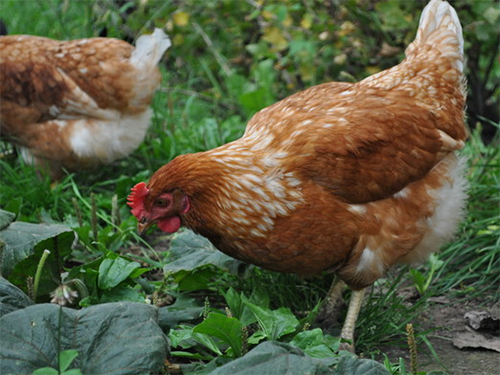
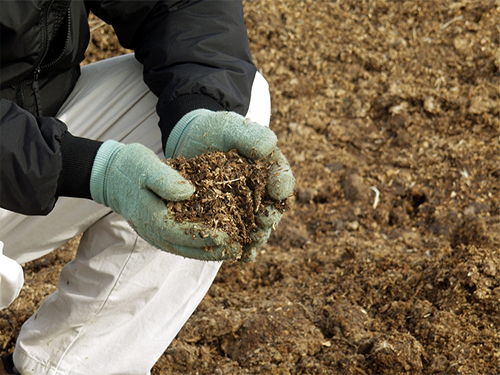
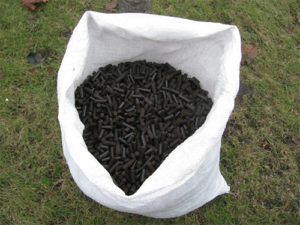
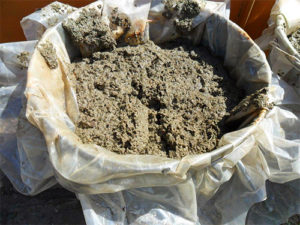
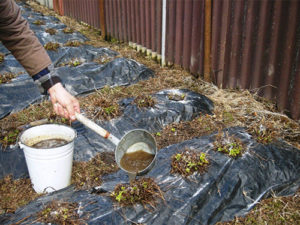

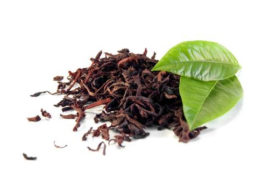
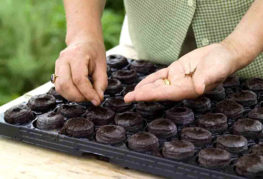
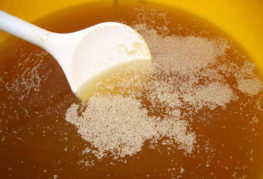
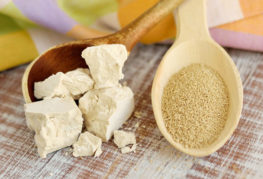
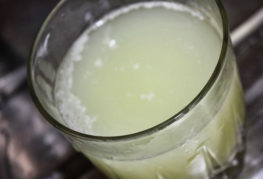
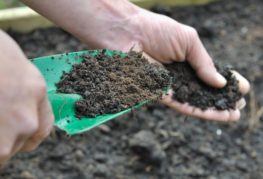
On the advice of a neighbor in the country, she began to use chicken manure as fertilizer. I used granular so that there was no strong smell. I tried it on potatoes - when planting, I poured a few granules into each hole, I liked the result very much - and the tops grew well, and there were a lot of large potatoes. In total, a whole wheelbarrow was collected from three beds of 20 bushes! Now I plan to master droppings on other crops.
We moved to live in a private house with a small vegetable garden. The first year we completely planted the garden, although we immediately noticed that the soil is not very good. The result is a small crop. This year we tried to add droppings under the potatoes. We put a layer of 4-5 cm and dug up the ground. The next day they planted potatoes. I noticed that the grass grows less, where the soil is with fertilizer. The crop has not yet been harvested, let's see what happens.
I have been using the litter for a long time with the result.
every year we WEAR chicken droppings and SPREAD over the site. Potatoes GROW very good
We collect 35-40 buckets from a hundred.
Sodila potatoes survived the litter from chickens under each potato she sprouted well blooms went to pull out the bushes, bring in little potatoes and small ones I'm afraid there won't be potatoes